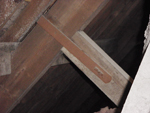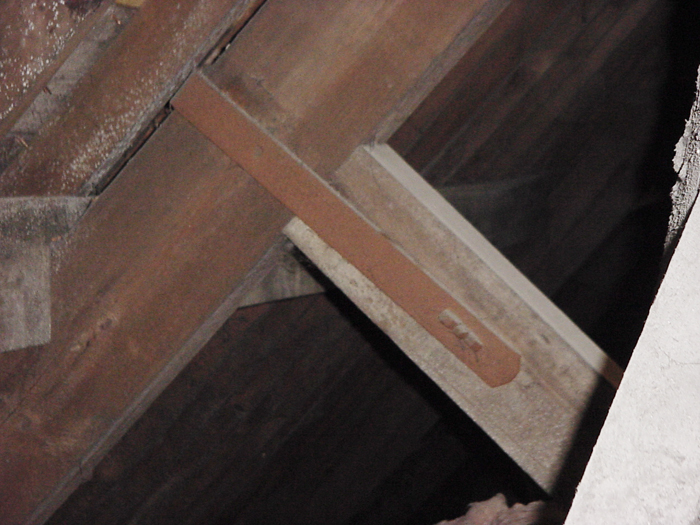Raising the roof!
 Consultant Timber Technologist and historic woodwork specialist Jim Coulson, of TFT Woodexperts, looks back on 35 years of investigations into old roofs: many of which have been in ecclesiastical buildings; and he composes a “Hymn of Praise” to the timber roof.
Consultant Timber Technologist and historic woodwork specialist Jim Coulson, of TFT Woodexperts, looks back on 35 years of investigations into old roofs: many of which have been in ecclesiastical buildings; and he composes a “Hymn of Praise” to the timber roof.
I’ve been inside a lot of cathedrals, churches and chapels in my time: not because I'm especially religious, but because there was usually something going on with the roof that needed looking at.
And there’s an amazing variety of ages, styles and conditions of Ecclesiastical Roofs out there, in the UK!
In more than 35 years of investigating roofs – among many other things made from timber – I have learned to have a great respect for wood: a material we rather tend to take for granted, since mankind has been intimately involved with it for thousands of years. In spite of frequently being neglected, wetted, burnt, overloaded and generally abused in some way, wood has a tremendous capacity for doing more than you expect, and for simply “being there” for much longer than you have a right to expect of it. In this little article, I would like to sing my own Hymn of Praise to the not-so-humble timber roof.
Wetting
It takes a long time to deteriorate large-section, historic timbers in roofs through water leakage: but they will eventually need some love and care, if left too long; and sometimes even a Timber Technologist can do nothing except recommend their replacement – with suitable recommendations as to how to minimise or avoid such a problem in future. But even rot – which alarms a lot of the people who have responsibility for the maintenance and repair of historic structures – is frequently not as bad, or as potentially devastating, as it looks to the untrained eye. Rather than call in the remedial treatment boys for a “free quote” (which almost always ends up with recommendations for chemical treatments and/or cutting out and replacing a lot of timbers), I think it is much better to ask an independent wood specialist to undertake a Condition Survey and then write a specification for what is actually needed: and which in my experience is frequently much less than the “free” surveys come up with. Burning
Burning
Wood doesn’t burn!...well all right, it does burn, as a fuel, when it’s caught up as part of a fully developed fire. But it does not easily ignite; nor does it burn very quickly, or lose its strength when exposed to fire. I have investigated a number of high-profile fires (York Minster being the most famous example in recent decades) and always, we find that the large timber roof elements are only slightly charred, with every prospect of re-use and, where appropriate, re-instatement. The usual cause of a timber roof collapse in a serious fire is the failure of the metalwork – wrought iron straps, bolts, etc – not the wood!
Overloading
In past centuries, builders and architects didn’t “do” calculations...if something stood up and stayed up, it was more by good luck than good design. (Many of the Historic structures we admire today are simply the “survivors”, that didn’t collapse after 10, 50 or 100 years!) And even some of the older buildings that we can still see today, are often afflicted by “creep”: this is phenomenon whereby timbers which have held a heavy load for centuries are gradually sagging under that weight – but without breaking. Sometimes, reinforcement is the solution: but often a Timber Survey and proper in-situ structural grading, to assist the modern timber engineering calculations, will show what needs to be done – if anything – to keep that structure standing up for a few more centuries.
Roof Styles and Wood Species
Timber has been used for roofs for millennia: and the religious buildings which (mostly) feature wooden roofs have slowly followed the changes in design and construction over the centuries. Oak was common in the Middle Ages and is found right up to the end of the 18th Century, “pegged” trusses with “tusked” purlins: but after that, large-section softwoods were much more the norm, with the advent of new-fangled wrought-iron strapping to hold the members together. And in later Victorian times – which saw a great number of new churches, and especially chapels, being erected – the Roof Truss reached new heights (pardon the pun!) of engineering sophistication: also using many of the newly-arrived timbers from the Dominion of Canada – such as Douglas Fir – in place of large-section Scandinavian pine, which was becoming harder to obtain at a good price.
So, whenever I get up into the roof of an old church, chapel or cathedral, I never know quite what I’m going to find: but one thing I do know – the wood will be doing a much better job than the original builders had any right to expect – and it will be coping quite well with all of the abuse that the centuries have heaped upon it. It just needs a bit of Expert help – preferably from a Consultant Timber Technologist and a Timber Grader – to make it last a few more centuries, into the next Millennium.
• Jim Coulson is a Fellow of the Institute of Wood Science and a Fellow of the Faculty of Building, and a Past President of the Institute of Wood Science. He sits on the Board of the Wood Technology Society (a division of the Institute of Materials Minerals & Mining); he is also is a member of the UK Timber Grading Committee and a member of the National Executive of ICOMOS-UK (the International Council on Monuments and Sites). He is the author of a new book published by Wiley-Blackwell in 2012: “Wood in Construction: how to avoid costly mistakes”.
For more information about TFT Wood experts visit www.woodexperts.com















